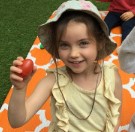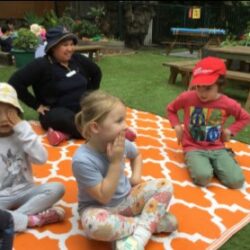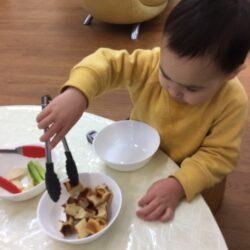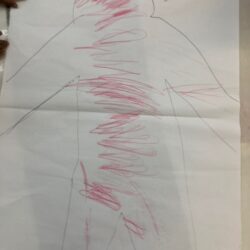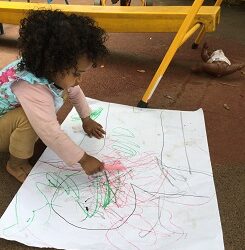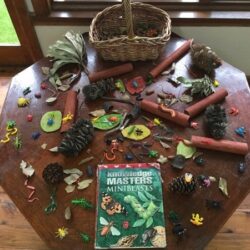Johnson House
Story by Speech Pathologist Kacey
Music and movement has been an area of interest for many children in Johnson House recently. A music and movement group, co-facilitated by Speech Pathologist Kacey and an educator, is planned to facilitate children’s participation, excitement and inclusion. The playlist of songs is carefully planned out to ensure the children remain engaged and regulated throughout.
We start by sitting on the mat and singing some songs that involve simple actions. As we warm up, we include the use of an instrument—an egg shaker. The middle of the group sees us up and moving about the space—we do a ‘freezing song’ and the ‘wombat wobble’! To finish off, and to calm ourselves back down, we use tapping sticks to accompany songs in a slower in tempo.
Children feel music both physically and emotionally. Music experiences promote attachment and a safe learning environment. Additionally, music can also support essential movement learning. A child’s brain is built for movement, and essential brain connections are put in place through movement. Continual and regular movement is compatible with a child’s growing brain and ensures greater wellbeing. Children who experience rich kinaesthetic and varied movement experiences (supporting good gross and fine motor skills) will have a stronger sense of self-esteem.
We look forward to continuing to incorporate music and movement regularly into our program.
Murray House
Infants
Story by Educator Jung
Educators in Murray House infants’ room are currently working on supporting children’s transition to the toddler program. Over the past few weeks educators have been taking a group of children to visit the toddler’s playground. We see the positive outcomes for children as they are observed having so much fun playing, and they often say “no” when they are asked to come back to the infants’ space!
Educator Dalia has been focusing on providing an experience that supports the development of self-help skills, as the children will be encouraged to learn more everyday life skills in the toddlers’ program. During mealtimes Dalia has introduced a small jug from which the children are encouraged to pour their own milk or water into their drinking cup. This has been a challenging experience for some children as it involves skills such as hand-arm coordination and motor planning abilities. Still, with lots of guidance, most children have been successful. Educators in the infants’ room will continue to implement strategies to support a smooth transition to the toddler space, and we hope that the children gain confidence, build familiarity with the new environment and transition successfully in the future.
Toddlers
Story by Occupational Therapist Lisa
This Monday was the third week of our integrated ‘Colour Monster’ group, facilitated by Occupational Therapist Lisa and an educator. At the beginning of our group session we revisited our ‘Listening Larry’ rules. Listening Larry helps us to remember what our bodies should be doing when we are actively listening. For example, we use our eyes to look at the person talking, we keep our arms and legs still, we use our brain to think about what the person is doing/saying and we use our ears to listen.
Then it was time to say hello, and sing “If you’re calm and you know it” and “If you’re scared and you know it”—there were some great expressions from the children for both of these emotions!
Next we read our book, The Colour Monster. It’s great to see that the children are remembering parts of the book, and they are now able to share when the Colour Monster is feeling all mixed up, and are beginning to be able to label his different emotions. This week’s focus was ‘sad’, and we discussed how a few of the children had felt sad this morning for different reasons. One child said that he felt sad because he thought Mandy might take her group without him (she didn’t!), another was feeling sad after she had fallen over, and her friend said that he felt sad after saying goodbye to his mum. We all agreed that a good way to help us feel better if we are sad is to have a big hug.
So, for our activity this week, using some large pieces of paper, we traced each child with their arms up ready to give a hug. Next the children decorated their hugs and we helped them to think about who they would like to share their hug with. Lisa sent a message out to parents: “I am sure that you will feel the love the children put into their hugs when they bring them home today!”
Finally, we finished our group with a meditation, listening to some calm music and looking at the sensory bottles, before taking a deep breath in and out to help us feel calm and ready to go and play again!
Robinson House
Story by educator Katie
The children have been showing an interest in nature, including insects. I set up a nature table with the children in the studio. We added some provocations such as leaves, small sticks, lavender flowers, seed pods, banksias and pine cones, after collecting some of these natural resources on our walks together in our grounds and from our centre yard.
We also added a book to the nature table to extend our learning, to help us to begin studying some images and to learn some more information and facts about the insects. To extend this interest further, I encouraged the children to paint paper towel rolls to use as wooden logs, and to make cardboard painted leaves. This was an opportunity for us to add to the learning spaces using ideas we’ve learnt and discovered using creative arts.
I encouraged the children to explore the nature table and facilitated discussions about the different creatures on the table, their features, how they move, their colours and the sounds they make. Some of the children stayed for a long time and seemed to enjoy this experience and new learning space. This experience helped the children to become more familiar with the natural environment in which they live, and to learn about different creatures. Children also extended their language and literacy skills through play and looking at the nature book, as well as engaging in creative imaginary play.
